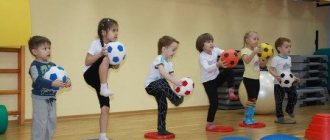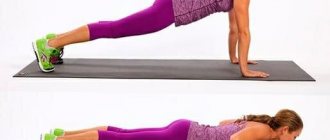Beginners often cannot decide on the choice of training program. There are many variations on the Internet: three-day splits, full days, top-bottom splits and others. Therefore, the question arises - “which program is the most effective” ?
In this article we will look at the types of training programs and their effectiveness. You will learn how to choose the right training program depending on your level of physical fitness and the number of workouts per week.
What is a training program?
A training program is a specific set of exercises that will help you achieve various goals, for example, increase strength, gain muscle mass, or prepare for competitions.
The training program allows you to systematically approach the training process
However, a good training program is not just a set of exercises, but also a number of required components:
- Individual load value. As a rule, ready-made programs on the Internet are a simple set of exercises, where the number of approaches and repetitions is written.
Such parameters are not enough, since the number of approaches and repetitions depends on your level of physical fitness. For example, if you are a beginner, then there is no point in training every day. Many ready-made programs on the Internet are designed for people with good physical data; such a high load is not suitable for beginners, as it can lead to overtraining. Therefore, the load is selected individually according to your parameters.Any good training program contains information about the goals, load levels and components described below.
- Instructions for progression of loads. Gradually, the body gets used to the loads, so they need to be increased so as not to get stuck in place.
For example, a person has been training with the same weight for several weeks. He did the required number of repetitions, the weight seems lighter with each workout. The muscles have adapted to the load, so you need to increase it.
If the load is not increased, the body will get used to it and will not develop. You will stop gaining strength, growing muscles, developing endurance, etc.
The training program should describe how to increase the working weight, the number of approaches and repetitions
Learn how to properly increase the load in training
- Duration of rest between approaches, exercises, training days. Many people forget to monitor rest intervals. However, these parameters affect the load level.
Find out how long to rest between sets
Planning, programming and periodization of sports training[edit | edit code]
Source: " Training programs
"
, scientific publication. Author:
Prof. Dr. Tudor Bompa, 2021
Strength Training Basics
- Physical qualities of a person
- Contraction of skeletal muscles, Physiology of muscle contraction Mechanism of muscle contraction and types of muscle contractions!!!
- Muscle strength
- Adaptation to physical activity
- Energy systems of the body Anaerobic alactic capacity
- Anaerobic lactate capacity
- Aerobic capacity
- Maximum Oxygen Uptake Capacity Training
- Development of joint mobility
- Gradual increase in load
Program development
- Managing Training Variables Training Volume
- Strength Training Intensity
- Number of exercises per muscle group
- Order of exercises
- Number of repetitions for mass and strength in the exercise
- How many approaches to do
- Rest between sets
- How often to exercise
- Sprint training
Periodization
- Anatomical adaptation
- Training program for gaining muscle mass
- Powerlifting training
- Special training Power training Isotonic training technique
- Ballistic training technique
- Resistance Power Training Technique
- Plyometric training
- Strength endurance training
- Reactive power
- Starting power
- Strength training plan
- Gym workout plan
Types of training programs

Types of training programs
There are two types of training programs: split and full body.
Full Body (fulbadi)
Fulbadi is training all muscles in one session.

Fulbadi - working all muscles in one workout
As a rule, the complex consists of 6-8 exercises. This version of the training program is great for beginners and allows them to quickly adapt their body to the load.
On our website there is a ready-made fullbadi program for beginners that you can start practicing. It is suitable for men and women.
Click to view the Fulbadi training program
Split

Split - dividing the body into parts and training them on different days
Split is the division of the body into parts and training them on different days.
Split is not suitable for beginners, since the load on the muscles is much greater than in full body. You can switch to split after mastering the exercise technique and several months of training.
Beginners have small weights on the barbell and small dumbbells, so split training is not practical. The workouts are not as intense.
There are many split options. Here are some of the most popular:
Classic split option
Day 1
- Breast
- Biceps
Day 2
- Back
- Triceps
Day 3
- Legs
- Shoulders
The second option for a three-day split
Day 1
- Breast
- Triceps
Day 2
- Back
- Biceps
Day 3
- Shoulders
- Legs
Four day split
Day 1
- Breast
- Biceps
Day 2
- Back
- Triceps
Day 3
- Shoulders
Day 4
- Legs
Five day split
Day 1
- Back
Day 2
- Breast
Day 3
- Legs
Day 4
- Shoulders
Day 5
- Hands
Split top/bottom
Day 1
- Upper body
Day 2
- Lower body
Power training
This kind of training involves us doing exercises to build and strengthen the muscles in our body. Typically, during strength training, you provide resistance (weights) to your muscles, and you lift or move a weight for several repetitions. After several weeks of such training, the muscles respond to the load, they begin to grow and become stronger, now the weight should be increased so that the muscles continue to develop. Strength training is good for those who want to stay toned; The stronger and larger your muscles become, the more calories you will burn even at rest. Strength training is also great for maintaining bone structure.
Checklist for selecting a training program
The selection of a training program is carried out in stages. Many people miss assessing their physical condition and determining their level of readiness for training. The type of training program and the amount of load depend on these parameters.
For you, we have compiled a step-by-step algorithm for selecting the optimal training program.
- Determine your level of readiness for stress. Without this, you will not select the required number of approaches and repetitions, or the type of training program.
- Determine your training frequency. Based on your capabilities (how many times a week you can train) and your readiness for stress.
- Choose a ready-made program or create your own. Based on the number of workouts per week and level of readiness, select the optimal type of program.
Select a training program
- Keep a training diary. It will help you record your current load and gradually increase it. Without this, the body quickly adapts, and training will not make sense.
Learn how to keep a workout diary
Methodological planning of a training program[edit | edit code]
«Methodical planning of the training program
»
Scientific manual ed.
Professor L.P. Lysova, 2016 Training programs
- How to create a training program
- Creating a split program
- Training program for beginners - mass gain
- Training program for beginners
- Beginner program for girls
- Training program for girls
- Preparation of individual training for women
- Strength training and fitness programs for women
- Bodybuilding training program for women
- The best training programs for mass
- The best training programs for mass
- Training program for professionals - mass gain
- Bodybuilding at home Training program for bodybuilding at home Home training programs
Muscle Physiology
- Physical performance
- Preparing for sports
- Best time to train
- Oxygen debt
- Anaerobic threshold
- Respiratory coefficient
- Energy equivalent
- The effect of physical activity on heart rate
Basic principles of training
- Sports training Goals and objectives of sports training
- Principles of Sports Training
- Planning a sports training
Force
- Strength training program
- Strength training program
- Strength training techniques Methods for measuring muscle strength
- Strength exercises
- Strength training for children and teenagers
Endurance
- Muscle adaptation to endurance training
- Sports heart
Coordination
- Coordination of movements Development of coordination
Speed training
- Speed training
Muscle stretching and mobility training
- Development of flexibility Ideomotor training
Specific muscle training using the example of athletics
- Sprinting and strength training
- Jumping and strength training
- Throwing and strength training
- Running and strength training
- Maximum strength
- Fast Power
- Reactive force
- Strength endurance
- Long-term types of sports training planning General developmental exercises and training - add what kind of general developmental exercises there are
- Specialized training
Muscle fatigue
- Muscle fatigue
- Krepatura
- Neurorehabilitation
- Sports rehabilitation muscle power
- dexterity
Joint Taping (Tutorial)
- Taping fingers
- Taping of the wrist joint
- Taping the elbow joint
- Taping the knee joint
- Taping the ankle joint
- Kinesiology Muscle Taping (Tutorial)
Conclusion
A training program is the basis for achieving any training goals.
While studying according to the program, you will be able to gradually increase the load and monitor its dynamics, which is one of the conditions for progress. The training program must be selected based on the current level of readiness for stress, frequency of training per week, availability of equipment, etc. Therefore, you need to approach your choice responsibly. Your future success depends on this.
If you are choosing a program for the first time, then contact a trainer who will help you create the right program and tell you how to increase the load, select working weights, etc.









